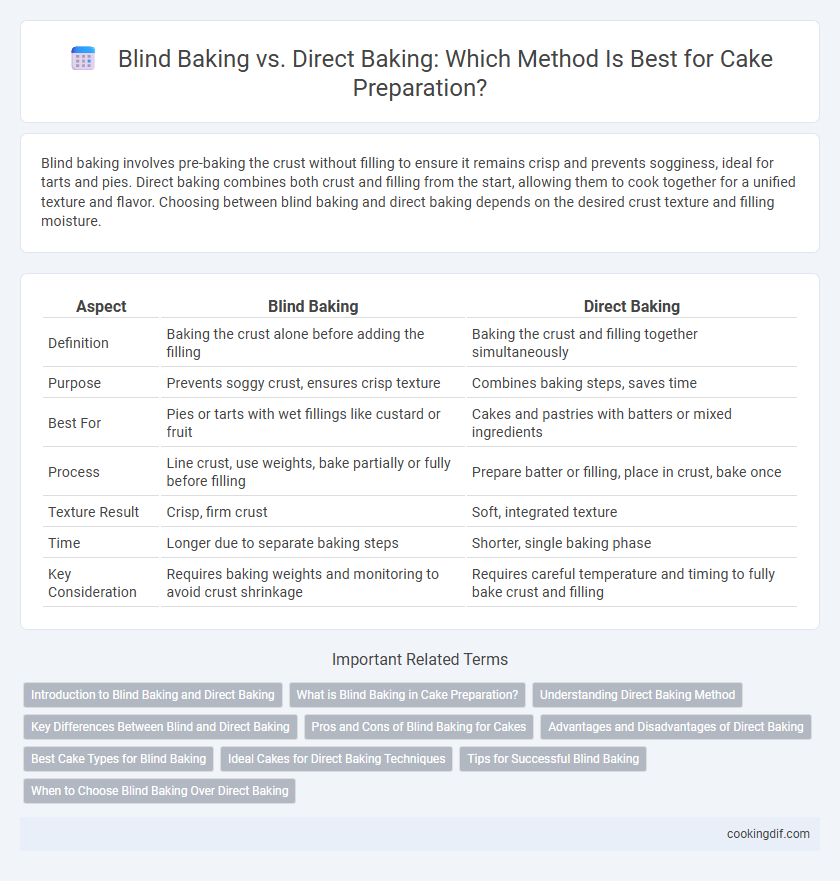Blind baking involves pre-baking the crust without filling to ensure it remains crisp and prevents sogginess, ideal for tarts and pies. Direct baking combines both crust and filling from the start, allowing them to cook together for a unified texture and flavor. Choosing between blind baking and direct baking depends on the desired crust texture and filling moisture.
Table of Comparison
| Aspect | Blind Baking | Direct Baking |
|---|---|---|
| Definition | Baking the crust alone before adding the filling | Baking the crust and filling together simultaneously |
| Purpose | Prevents soggy crust, ensures crisp texture | Combines baking steps, saves time |
| Best For | Pies or tarts with wet fillings like custard or fruit | Cakes and pastries with batters or mixed ingredients |
| Process | Line crust, use weights, bake partially or fully before filling | Prepare batter or filling, place in crust, bake once |
| Texture Result | Crisp, firm crust | Soft, integrated texture |
| Time | Longer due to separate baking steps | Shorter, single baking phase |
| Key Consideration | Requires baking weights and monitoring to avoid crust shrinkage | Requires careful temperature and timing to fully bake crust and filling |
Introduction to Blind Baking and Direct Baking
Blind baking involves pre-baking the crust before adding the filling, ensuring a crisp, fully cooked base that prevents sogginess in delicate cakes or tarts. Direct baking, on the other hand, means baking the cake batter with the crust simultaneously, allowing flavors to meld but risking a softer bottom layer. Understanding the applications and outcomes of both methods helps achieve the desired texture and structural integrity in various cake recipes.
What is Blind Baking in Cake Preparation?
Blind baking is a technique in cake preparation where the crust or pastry is partially or fully baked before adding the filling, ensuring a crisp and firm base. This method prevents sogginess by allowing the crust to set and cook evenly without absorbing moisture from wet fillings. Commonly used for tarts and custard-based cakes, blind baking involves lining the dough with parchment paper and weights such as beans or rice to maintain its shape during baking.
Understanding Direct Baking Method
Direct baking involves placing the cake batter straight into the oven without pre-baking the crust, allowing the cake to cook evenly and retain moisture. This method is ideal for simple sponge cakes and batters that require uniform rising and texture. Unlike blind baking, direct baking eliminates the need for a separate crust preparation, streamlining the cake-making process.
Key Differences Between Blind and Direct Baking
Blind baking involves pre-baking the cake crust without any filling to prevent sogginess and ensure a crisp texture, commonly used for tart and pie bases. Direct baking cooks the entire cake batter or filled crust simultaneously, ideal for cakes where the filling integrates during baking, resulting in a more cohesive texture. Key differences include the preparation process, moisture control, and suitability for different cake types--blind baking offers precise crust texture control, while direct baking simplifies overall preparation.
Pros and Cons of Blind Baking for Cakes
Blind baking, or pre-baking the cake crust without filling, ensures a crisp and firm base that prevents sogginess, especially for wet or custard fillings. This method can be time-consuming and requires careful monitoring to avoid over-browning or cracking of the crust. Blind baking is ideal for maintaining texture integrity in delicate cakes but may not be necessary for recipes where the filling naturally cooks the crust.
Advantages and Disadvantages of Direct Baking
Direct baking involves placing the cake batter directly into the oven without pre-baking the crust, resulting in a simpler, faster preparation process that preserves moisture and tenderness in the cake. However, this method may cause the crust to become soggy or undercooked if the batter releases too much liquid during baking. This technique suits dense cake recipes but can compromise texture and crust integrity in delicate or moisture-rich cakes.
Best Cake Types for Blind Baking
Blind baking is ideal for tart and cheesecake crusts that require firm, crisp bases to prevent sogginess from wet fillings. Pie crusts, quiches, and certain delicate pastries like custard tarts benefit from this method to maintain structural integrity during baking. Cakes with wet or custard fillings, such as lemon tarts or pecan pies, perform best with blind baking to ensure a fully cooked, non-soggy crust.
Ideal Cakes for Direct Baking Techniques
Direct baking suits dense, moist cakes like pound cakes, banana bread, and carrot cake, where the batter supports itself during baking without requiring a separate crust. These cakes develop a rich, tender crumb through even heat distribution without the need for pre-baking techniques. Avoid delicate or high-moisture cakes that rely on crumb structure from blind baking to maintain shape and texture.
Tips for Successful Blind Baking
Blind baking enhances cake crust texture by pre-baking the crust before filling, preventing sogginess, while direct baking involves baking the crust and filling together. For successful blind baking, use pie weights or dried beans to keep the crust flat, prick the dough with a fork to release steam, and chill the crust before baking to avoid shrinking. Maintaining an even oven temperature around 375degF (190degC) ensures a golden, crisp crust essential for layered or filled cakes.
When to Choose Blind Baking Over Direct Baking
Blind baking is essential when preparing delicate cake shells or tart bases that require a crisp texture before adding wet fillings, preventing sogginess. It is preferred when using custard or fruit fillings that do not require further baking, ensuring a fully cooked crust. Direct baking suits recipes where the batter cooks uniformly together, making blind baking unnecessary for cakes with moist, integrated fillings.
Blind baking vs Direct baking for cake preparation Infographic

 cookingdif.com
cookingdif.com